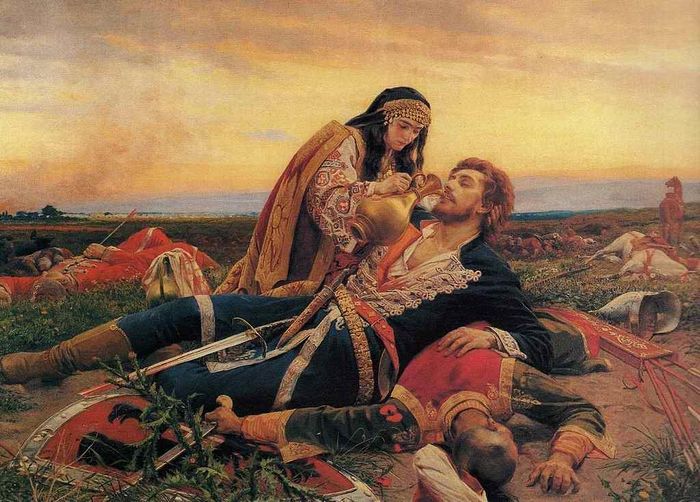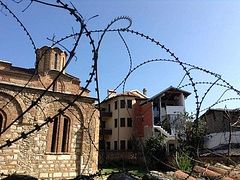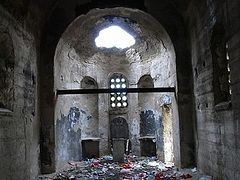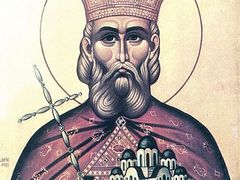Today is the feast of Serbia’s St. Lazar, who gave his life for his people on Kosovo field. King Lazar chose the Heavenly Kingdom over the earthly kingdom, and became Serbia’s protector for the ages.
Blessed Lazar Hrebeljanović was related to the Grand Prince Stefan Nemanja. Under King Uros, he ruled the region of Srem near the Danube and in 1371 he became Prince of Serbia.
The Principality was in a deplorable state, and Lazar had to take prompt actions to remedy the situation. First of all, he dealt with the willfulness of regional rulers. Nikola Altamanovic, the Governor of Herzegovina, more resembled the leader of a gang of robbers than the protector of peace and morality—with bands of corrupt people like him he would attack his neighbors, robbing and murdering them. Prince Lazar with his strong army marched towards the brigand. When the latter hid in the fortress of Uzice, Lazar besieged it, demanded that Altamanovic be given up to him, and ordered him to be blinded and taken abroad. After that he crushed Radič Branković at Branicev. To complete the victory, Lazar went through Dalmatia and Bosnia with his troops. Having driven the Hungarians from Srem and Macva, he annexed most of the lands on either side of the Tisza to Serbia.
To prevent the governors from putting their personal interests above State interests, Lazar married his daughters to them. After such heroic deeds, the whole of Serbia declared him its supreme ruler.
The Patriarch of Constantinople was angry with the Serbian rulers proclaiming the archbishop as Patriarch and the ruler Dusan as King. Indignation reached its peak when on conquering the Greek regions King Dusan put the churches that had earlier belonged to the Patriarchate of Constantinople under the jurisdiction of the Serbian Patriarchate and expelled the Greek bishops from his dominions. In 1368, Despot Jovan Uglješa transferred the churches in his region to the Patriarch of Constantinople’s jurisdiction. Blessed Lazar suggested that they settle the dispute by a peace agreement. At the Synod of the Patriarch of Constantinople it was decided to preserve the rights of the independent Archbishop of Serbia and give him the title of Patriarch, but only on the territory of Serbia. The new Patriarch Ephraim crowned Lazar as the Serbian King.
After that, Serbia enjoyed ten peaceful and tranquil years. Lazar invited people to the towns that had been ruined in the troubled times. The rich silver mines in the mountains revived the country’s industry and trade.
Lazar’s piety was revealed in his numerous deeds. In the charter of 1380 “the Right-Believing Prince Lazar” endowed Hilandar Hospital with the village of Elcanitsa and added a porch to the main church. In the same year he gave several villages to the Church of the Entry of the Most Holy Theotokos into the Temple, which he had himself built in Gornak for a newly-founded monastic community. In the charter of 1381 he endowed the Russian St. Panteleimon’s Monastery with a village (Dlabe) and the Church of the Savior in Hvocne and took the title of builder-benefactor of St. Panteleimon’s Monastery. At the holy royal monastery of Oleškovici in the Kucaj Mountains Lazar built the church of the Holy Trinity.
The special memorial to Lazar is his “zadusbina” (“foundation for his soul”)—Ravanica Monastery. In the 1381 charter he wrote: “Imitating the pious kings who reigned before me and on whose throne God has put me, I have made up my mind to make a sacrifice within my power by building the Holy Ascension Monastery, adorning it and providing the brethren with living quarters, as was decreed by the apostles. I have prepared enough of everything: income and villages, planted some vineyards and bought other ones… All I have bestowed are nobody’s possessions—so I have not used violence against anyone… Let your abbots not be elected from outside, but let them be elected from among the monastery brethren on conferring with the prince…” Prince Lazar also took care of the Christian education of people.
Terrible tribulations awaited Serbia. By that time, the savage Ottomans had already secured a foothold in Rumelia and conquered Bulgaria. Epirus and Albania acknowledged their vassalage to the sultan. There was no end to the Ottoman violence.
In 1387, Lazar decoyed many thousands of Ottomans into the gorges of Epirus and few of them managed to escape his sword. The proud Ottomans vowed to annihilate the Serbs. Sultan Murat led a huge army against Serbia. He demanded either full submission or a decisive battle from Lazar. The prince answered in a respectful manner: “I was enthroned by the princes and nobles of the whole Serbian land. I cannot submit to you without breaking the oath I swore to my people. Wait. I will gather people. If they tell me to submit to you, I will bow down before you in everybody’s presence. If not, I must throw down the gauntlet against you.”
The sultan promised to wait for an answer for seventeen days. Some regional governors who were with the prince advised him to submit, but Lazar’s reply was the same as that to the Sultan. Letters were sent to all the regional governors to come immediately with troops if they did not want to become the Sultan’s tributaries. The strong Prince of Zaholm was unable to come in time, and thus Lazar’s forces were 60,000-strong against 300,000 on the Ottoman side.
The decisive battle was to take place on June 15, 1389, on Kosovo Polje. On the eve everyone gathered to take counsel with the prince, and Lazar felt gloomy. Early in the morning, at the archpastor’s advice, the prince together with his entire army recieved Communion.
Milos and his three friends penetrated Murat’s camp by deceit. They asked to be taken to Murat allegedly to reveal some secret. Having entered the tent, Milos snatched his sword and killed Murat. The Sultan’s servants were rooted to the spot in terror. Milos and his companions rushed to mount the horses, but they were instantly surrounded and cut to pieces. If the Serbs had made use of the confusion following Murat’s death and had attacked the Ottomans, an overwhelming victory would have been guaranteed. But Vuk Brankovic, a secret friend of Vukašin’s son who had defected to the Mohammedans, spread rumors that Milos had allegedly gone over to the enemy’s camp as a turncoat, and panic in Lazar’s camp began. It took Lazar much time and strength to convince his armed force not to believe the rumors.
In the meantime, Murat’s son, Beyazit, succeeded his murdered father as the head of the Ottoman horde. Encouraged by Lazar, the Serbs decided to sell their lives dearly. Lazar commanded the center and the right flank and the left flank was commanded by Gjergj Kastriot with the Albanians. Vuk Brankovic volunteered to stand in the rear as a reserve regiment to reinforce the soldiers when needed. The Ottomans’ massive pressure was repulsed adequately and soon the enemy began to retreat. But at the same time the Ottoman reserve detachments entered the fray and a ferocious battle resumed.
The battle lasted five hours. The fighting Serbs needed reinforcements, but Brankovic didn’t budge. Lazar was fighting in the front. Wounded, he ran to change his overworked horse. The Serbs wavered. At the head of the army again, he tried his best to keep the wavering soldiers under control. The foe, making use of the disarray, delivered a decisive blow against the Serbs. Almost the whole host of Lazar fell at Kosovo Polje, and the few who survived were taken prisoner. Only Brankovic, who remained where he was, came out unscathed with his forces. Lazar, all in wounds, was taken captive and led to Beyazit. The latter ordered him to be beheaded.
The body of the martyred prince was buried in the nearest church of the Diocese of Priština. Two years and eight months later, when the coffin was opened, the body was found incorrupt. In a very solemn ceremony the prince’s remains were translated to Ravanica Monastery and laid in a marble coffin.





